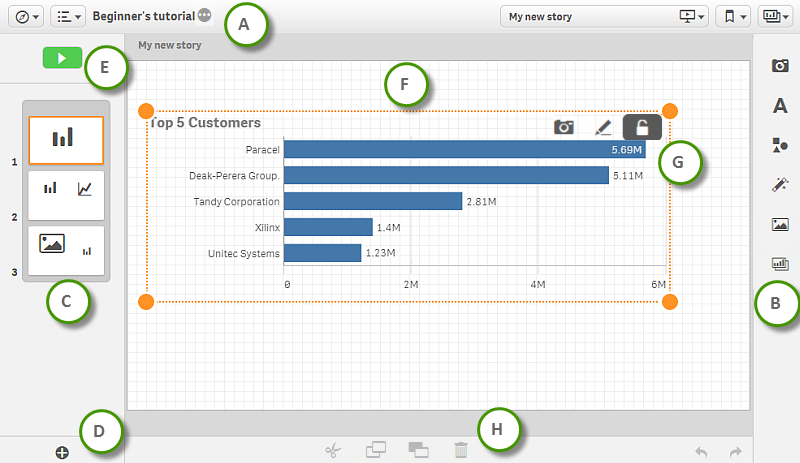You can open a story from the app overview or the sheet view by clicking Ç and then clicking on a story.
In storytelling view, you can do the following:
- Build stories to present insights and ideas based on your data discoveries.
- Play a story as it would be presented to an audience.
- Publish a story.
Build (edit)
You build stories by using snapshots of your visualizations. To make the stories look good you can add different kinds of visual effects and content such as text, shapes, images and effects.

| A |
The toolbar contains the global menu and useful commands.
|
|||||||||||||
| B | A set of tools and libraries to help build and your story and make it look good. | Story tools | ||||||||||||
| C | The story timeline gives you an overview of and control over the composition of your story. You can navigate inside the story using the slide thumbnails. | Story timeline | ||||||||||||
| D | Create new slides to add to your story timeline. | Adding a slide to a story | ||||||||||||
| E | Play the story before you make it available for others. | Playing a story | ||||||||||||
| F | You work with the current slide by inserting snapshots, text, shapes, and visual effects from the story tools. | Story slide | ||||||||||||
| G |
A selected unlocked slide item with resizing handles.
|
|||||||||||||
| H | Cut, copy, paste, and delete items on the slide. |
Play
When you play a story, through your snapshots, you can get access to the visualizations from where the snapshots originate. If you have embedded sheets into your story, you can make selections in these embedded sheets, just as you can in a sheet when you are analyzing.
These abilities bring your story to life and you can answer new questions from your audience and steer the story in new directions.
See: Playing a story
Touch gestures in storytelling view
The table describes the touch gestures that are used for navigating in storytelling view.
| Tap | Highlight a data point in a snapshot by applying an effect. |
| Double-tap | Edit a text object or an image. |
| Long-touch and release | Open the shortcut menu. |
| Long-touch and drag |
Move a slide to a new location in the timeline. Move an item on a slide. |
| Swipe |
Scroll the list in the snapshot library. Go to the next or previous slide when playing a story. |
